Preservation Pennsylvania recently announced the Pennsylvania At Risk 2014 list — seven properties nominated by the public last year that will become the nonprofit group’s work priorities in 2015. The list illustrates a range of threats to historic resources, including 1) demolition; 2) potential loss due to deferred maintenance; 3) loss of vitality due to closure of a downtown anchor; 4) impacts resulting from inappropriately sited intensive development; and 5) physical and economic challenges faced by municipalities as a result of substantial flood insurance premium increases. Preservation Pennsylvania is ready to engage with people interested in working to protect these significant historic places and work to overcome these threats in the coming year.
Muncy Historic District, Lycoming County
The Pennsylvania At Risk press conference was held in Muncy, Lycoming County, in conjunction with the Muncy Historical Society, as a means of calling special attention to an issue that poses a significant threat to the local Historic District and the borough as a whole.
Muncy was built along the banks of the West Branch of the Susquehanna River, which provided power and transportation to local industry and fueled the economy. As a result, 47% of the Muncy Historic District (483 buildings) is located within what is commonly referred to as the 100-year floodplain. Drastic increases in flood insurance premiums in the town, where property values and incomes are modest, are making it infeasible for many residents to remain in their homes and business owners to remain in the historic community core. Some buildings must be demolished and others may be abandoned. These losses will erode the fabric of the historic district, as well as the local economy, and threatens the historic district.
Muncy is just one of approximately 905 communities in Pennsylvania that participate in the National Flood Insurance Program (NFIP) and will be negatively impacted by changes resulting from the Biggert-Waters Act of 2012, which are now being implemented. Muncy has been listed in Pennsylvania At Risk to illustrate this significant national issue, and showcase the monumental challenges facing river towns in Pennsylvania and elsewhere in the country. Changes in federal policies regarding the determination of flood insurance premiums are needed in order for historic districts like Muncy to survive.
Other resources included on the Pennsylvania At Risk 2014 list include:
 Fairmount Park Welcome Center, Philadelphia
Fairmount Park Welcome Center, Philadelphia
This 1960 flying-saucer-shaped example of mid-century modern architecture may be demolished as a result of the redesign of John F. Kennedy Plaza (LOVE Park).
 Frank & Seder Department Store, Pittsburgh, Allegheny County
Frank & Seder Department Store, Pittsburgh, Allegheny County
This building, which was built in 1918 and housed Frank & Seder’s department store until 1958, is threatened by demolition to make way for a new high-rise office tower.
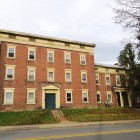 Susquehanna Female College, Selinsgrove, Snyder County
Susquehanna Female College, Selinsgrove, Snyder County
After serving as an educational institution for women from 1859-1872 and housing residential apartments for more than a century, the current owner of the former Susquehanna Female College has found rehabilitation to be financially infeasible and would like to sell the property. He believes the property is more valuable without the historic building, so plans to demolish it to facilitate the sale.
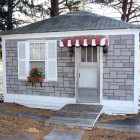 Lincoln Motor Court, Manns Choice, Bedford County
Lincoln Motor Court, Manns Choice, Bedford County
Lincoln Motor Court is the last surviving tourist court on the Lincoln Highway that is open to overnight guests. Despite the owner’s best efforts, some of the cottages now suffer from leaking roofs or collapsing foundations, and may soon be lost if funds aren’t raised for repairs and improvements.
West Chester Post Office, Chester County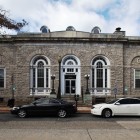
The prominent West Chester Post Office has provided a federal presence and served as an informal community meeting place in downtown West Chester for nearly 100 years. The post office has been closed, and while the building’s preservation is not threatened, the community will be impacted by the diminished government presence and loss of this facility that generates significant foot traffic downtown.
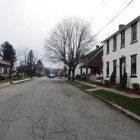 Harmony Historic District and David Ziegler Farmstead, Butler County
Harmony Historic District and David Ziegler Farmstead, Butler County
Now a National Historic Landmark district, George Rapp’s Harmony Society developed Harmony in 1805-1815. A developer plans to fill low-lying farmland across the Connoquenessing Creek from Harmony and build nearly 500 units of housing. This intensive development will alter the setting of the district and impact surrounding historic properties, put the historic community at greater risk of flooding, and potentially impact archaeological resources.
By identifying these endangered properties and threatening issues in Pennsylvania At Risk, Preservation Pennsylvania aims to 1) draw statewide attention to the plight of Pennsylvania’s historic resources; 2) promote and support local action to protect historic properties; and 3) encourage funding and legislation that supports preservation activities. Helping people to protect and preserve Pennsylvania’s endangered historic properties is a top priority for Preservation Pennsylvania. The organization is committed to engaging with people interested in working to preserve and rehabilitate these significant historic places and will work hard to do so in the coming year.
To learn more about these endangered historic properties and the issues that threaten them, download a copy of Pennsylvania At Risk.
Comment Policy
PHMC welcomes and encourages topic-related comments on this blog. PHMC reserves the right to remove comments that in PHMC’s discretion do not follow participation guidelines.
Commenters and Comments shall be related to the blog post topic and respectful of others who use this site.
Commenters and Comments shall not: use language that is offensive, inflammatory or provocative (this includes, but is not limited to, using profanity, obscene, or vulgar comments); disparage other commenters or people; condone illegal activity; identify the location of known or suspected archeological sites; post personal information in comments such as addresses, phone numbers, e-mail addresses or other contact details, which may relate to you or other individuals; impersonate or falsely claim to represent a person or an organization; make any commercial endorsement or promotion of any product, service or publication.
If you would like to comment on other topics not related to this blog post but related to PHMC, please fill out the PHMC Contact Us Form.
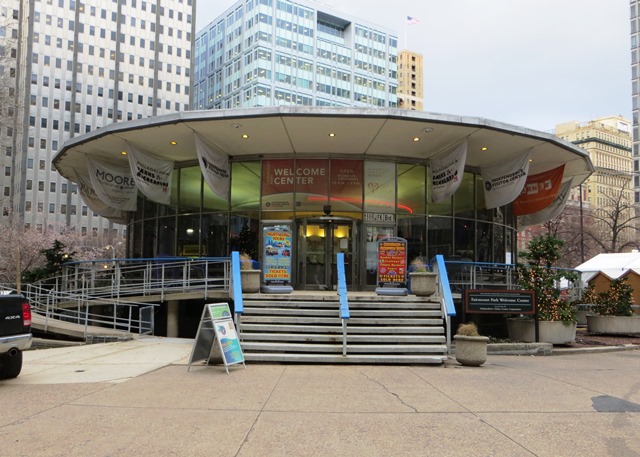
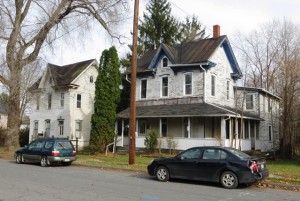
Leave a Reply